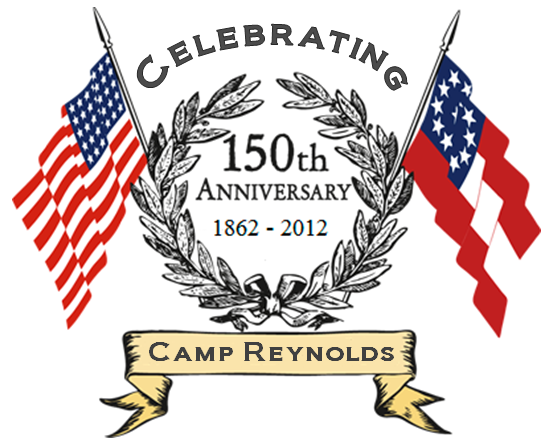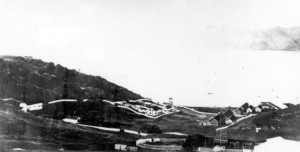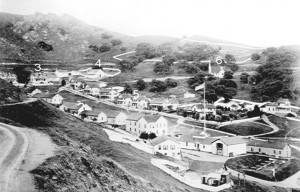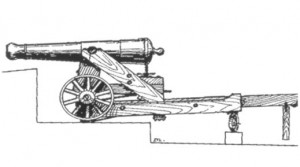Amenities

With concern mounting over threats to the Bay Area from Confederate sympathizers and naval forces, the federal government established Camp Reynolds (later known as the West Garrison when the whole island was Fort McDowell) on Angel Island in 1863. Artillery batteries were built near the camp at Point Blunt, Point Knox, Point Stuart and an unofficial “water battery” at the Camp Reynolds Wharf. Fears that the confederates might slip into the Bay and attack naval installations at Mare Island and the Benicia Arsenal were never realized.
After the Civil War, Camp Reynolds became an infantry camp, serving as a depot for recruits, and as a staging area for troops serving in campaigns against the Apache, Sioux, Modoc, and other Indian tribes. By 1876, this was a busy camp with over 2,000 soldiers and complete military camps or posts including a chapel, bakery, blacksmith, shoemaker, laundry, barber, trading store, and photographer.
 The earliest known photograph of Camp Reynolds. The majority of the buildings shown here were completed in 1863 and 1864. The two white-painted officers’ quarters, just to the left of center, were the first Army buildings erected on the island, and are still standing. Circa 1867
The earliest known photograph of Camp Reynolds. The majority of the buildings shown here were completed in 1863 and 1864. The two white-painted officers’ quarters, just to the left of center, were the first Army buildings erected on the island, and are still standing. Circa 1867
 Camp Reynolds, the numbered buildings show those buildings remaining today; (1) at the bottom right of the photo is the 1864 unofficial “water battery”, (2) shown diagonally to the left is the row of enlisted mens’ barracks, (3) officers’ Quarters 10, now restored, (4) the Mule Bar and corral, (5) includes the row of buildings, called “Officers Row”. and (6) the Chapel, which over the years served as both a place of worship and as a schoolhouse for the children living on the island. Circa 1890
Camp Reynolds, the numbered buildings show those buildings remaining today; (1) at the bottom right of the photo is the 1864 unofficial “water battery”, (2) shown diagonally to the left is the row of enlisted mens’ barracks, (3) officers’ Quarters 10, now restored, (4) the Mule Bar and corral, (5) includes the row of buildings, called “Officers Row”. and (6) the Chapel, which over the years served as both a place of worship and as a schoolhouse for the children living on the island. Circa 1890
 The Enlisted Men’s Barracks at Camp Reynolds; two of them were built in 1864, the other two in 1874. They were immediately across the parade ground from “Officer Row.” These barracks were razed by the Army in the 1930s. The cleft on the hillside above the barracks indicated the location of Battery Stuart. Circa 1880.
The Enlisted Men’s Barracks at Camp Reynolds; two of them were built in 1864, the other two in 1874. They were immediately across the parade ground from “Officer Row.” These barracks were razed by the Army in the 1930s. The cleft on the hillside above the barracks indicated the location of Battery Stuart. Circa 1880.
 Barracks Interior, Camp Reynolds. The upper floor of one of the barracks on the north side of Camp Reynolds parade ground. Each barrack was designed to hold one company of infantry. Company kitchens were located behind each barrack. Circa 1870
Barracks Interior, Camp Reynolds. The upper floor of one of the barracks on the north side of Camp Reynolds parade ground. Each barrack was designed to hold one company of infantry. Company kitchens were located behind each barrack. Circa 1870
 Parade Ground Inspections were held weekly, part of a rigorous schedule which included guard mounts, parades, drill, and fatigue (non-military) details. The routine varied little, and monotony was a part of life on the island. Fishing, sports, reading, and games of pool and cards were the chief forms of recreation. Circa 1895
Parade Ground Inspections were held weekly, part of a rigorous schedule which included guard mounts, parades, drill, and fatigue (non-military) details. The routine varied little, and monotony was a part of life on the island. Fishing, sports, reading, and games of pool and cards were the chief forms of recreation. Circa 1895
 U.S. 32-Pounder on Barbette Carriage. The Civil War artillery emplacements on Angel Island had a total armament of twenty-six guns, twenty-one of them smooth-bored 32-pounders like this one. There were three of these cannon at Point Stuart, seven at Point Knox, six at Point Blunt, and five were mounted in the unofficial “water battery” at the Camp Reynolds Wharf. Albert Manucy, Circa 1860
U.S. 32-Pounder on Barbette Carriage. The Civil War artillery emplacements on Angel Island had a total armament of twenty-six guns, twenty-one of them smooth-bored 32-pounders like this one. There were three of these cannon at Point Stuart, seven at Point Knox, six at Point Blunt, and five were mounted in the unofficial “water battery” at the Camp Reynolds Wharf. Albert Manucy, Circa 1860
 This is one of two 10 in. Rodman guns in Santa Monica that were given to the city by the Army ion July 4th, 1908. Both guns came from Battery Knox as surplus. These two were mounted on Angel island during the Civil War – circa 1864.
This is one of two 10 in. Rodman guns in Santa Monica that were given to the city by the Army ion July 4th, 1908. Both guns came from Battery Knox as surplus. These two were mounted on Angel island during the Civil War – circa 1864.
Our Community. Our Island. Our Legacy.
Angel Island Conservancy// PO Box 866 / Tiburon / CA 94920// info@angelisland.org// Tax ID No. 51-0152954// FACEBOOK// FLICKR// INSTAGRAM